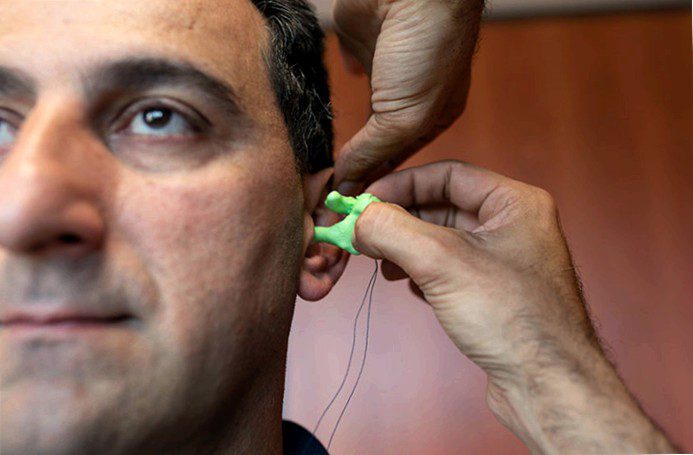The protection of the hearing is an important matter. That's why Cotral Lab has been providing custom earplugs for professionals in noisy work environments for more than 25 years.
You will be provided with hearing protection and ear impressions will be made shortly by Cotral Lab? Here are pictures and videos about the different steps you need to take. This is how we can best support you in this important protective measure.

Working with your hearing protection technician
The appointment with your hearing protection technician from Cotral Lab is made in advance with your responsible employee (SHE officer/ paramedic/ safety officer. ). coordinated.
We recommend that you provide a room large enough for several people (e.g. meeting room) and a period of 30 to 40 minutes for 5 employees, or. ca. 1 to 1,5 hours for 10 persons.
The technician will tell you if he notices a plug of earwax or an ear condition in an employee and will recommend that you see your family doctor or otolaryngologist.
On the day of taking the ear impressions, we will need a room equipped with chairs and tables and evtl. a room equipped with a beamer (for playing information material).
Procedure for taking ear impressions by Cotral Lab
The ear impressions are made in 6 steps:
#1 Raising employee awareness of the dangers of noise, information
The goal of every company must be to protect the hearing of employees in noisy environments and to provide employees with a better working environment.
This is the reason for hiring Cotral Lab.
Since 1996, Cotral Lab has been using its expertise as a training provider and the experience of its hearing protection technicians (who are also trainers) to raise employee awareness of noise issues while making impressions.
Cotral Lab has developed its own educational materials and provides the following information during the appointments:
- Function of the ear
- Raising awareness of the risks associated with noise exposure and how to protect yourself from it
- Raising awareness of the positive impact of hearing protection on overall well-being and health
- Functioning and correct use of the Cotral Lab hearing protection (insertion, fitting time, hygiene…)
- Techniques used in making ear impressions and what is felt during the process.
At the beginning of the appointment, the Cotral Lab technician will remind you of the most important facts in order to prepare you for the topic "hearing protection sensitize you and, of course, answers all your questions.
Then he will explain you how he proceeds to make the ear impressions.
It explains in detail the technique used and prepares you for what exactly you will feel in your ear. (For example, a slight coughing irritation may occur when the foam is introduced.)
The prevention technician also asks the future wearer about any ear surgeries, pain or infections.
#2 Choosing the type of hearing protection and the appropriate acoustic filter – SAPAN method
To best determine each person's individual needs, the technician takes the SAPAN approach.
SAPAN was developed by HearingProTech, a recognized expert on noise control. The method follows the recommendations of the EN-458 standard.
It allows you to adjust the attenuation of the hearing protector so that it is worn during the entire time of noise exposure – because only this guarantees effective protection.
Known for its reliability, the system makes it possible to choose the ideal hearing protection for the work environment and the individual circumstances of the future wearer, taking into account various criteria:
- Level of noise exposure
- Restrictions and requirements of the worker, e.g. regarding communication and/or perception of the environment
- Actual attenuation values of personal hearing protectors
- Recommended level of noise perception
The technician enters the employee's information via the software accessible on their smartphone to determine the ideal filter/protection combination.
Then scans the QR code on the packaging. The QR code can later be used to identify the employee's personal ear impressions.
#3 Otoscopy and protection of the eardrum
The technician always performs an otoscopy of the person's ear canal to determine any contraindications to making the impressions ( e.g. Plug from earwax, middle ear infection, recent surgery. ).
In case of complete or partial perforation of the eardrum, the advice of a physician must be sought.
The technician places a disposable speculum on the otoscope to verify that the ear canal is healthy and the eardrum is clearly visible.
He introduces a foam into the ear canal. To do this, he uses the Otopen attachment. This foam is provided with a string, with which it can be removed later on.
The foam protects the eardrum, stops the flow of impression paste and alleviates pressure fluctuations in the ear.
The position of the foam must be checked via the otoscope.
#4 Making the impressions
With the help of a special gun, the technician inserts the impression mass into each ear.
The person being treated must then remain quiet and not talk while the impression compound is drying.
The mouth must be kept relaxed and closed.
#5 Removing the impression
After the impression has dried (approximately after 3 to 5 minutes), the technician carefully pulls it out of the ear.
He removes the hook and rotates the impression a bit. The impression "screws itself out of the ear canal.
The hearing technician verifies that the impression is complete (foam and impression), that it matches the morphology of the ear, and that there are no abnormalities, such as air bubbles or folds.
If the impression is not in order, the technician repeats the procedure.
#6 Sending the impressions to Cotral Lab
After checking the ear impressions, the technician puts each pair of impressions in a bag and sends everything to Cotral Lab for making the personal hearing protectors.
The new protocol for taking ear impressions